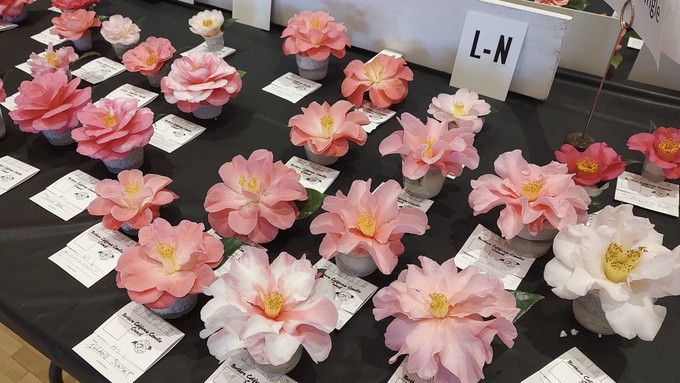
People brave stormy weather to celebrate milestone and see lots of flowers

These were just a few of the camellia blossoms entered for judging at the 100th Sacramento Camellia Show. Debbie Arrington
Updated
Rain couldn’t dampen Sacramento’s love of its favorite flower.
Over a soggy weekend March 2 and 3, more than 3,000 patrons – and hundreds of flowers – packed the Scottish Rite Center for the 100th Sacramento Camellia Show.
“We had more people than we’ve ever had, at least in many, many years,” said Julie Vierra, president of the Camellia Society of Sacramento and the show’s co-chair. “(The flow of people) was constant – it never stopped! We were very busy both days.”
The final tally, finished Monday night, was impressive: Some 47 exhibitors entered 1,743 blooms, Vierra said. More than 3,100 guests attended the show.
“It was the biggest show we’ve ever had, at least since the early days at Memorial Auditorium,” Vierra added.
Living up to Sacramento’s moniker as the Camellia City, the Sacramento Camellia Show is recognized as the nation’s oldest and largest show of its kind. It’s been a highlight of Sacramento’s garden calendar since its 1924 debut. For decades, it filled Memorial Auditorium with flowers as part of the city’s Camellia Festival.
For its century milestone, the show moved from the Elks Lodge in Greenhaven to the larger Scottish Rite Center near Sacramento State in the River Park neighborhood. The new location and extra space were a hit, Vierra noted. “People said how much more they liked it.”

Cold rain and wind – which can quickly batter tender camellia blooms – were an extra challenge for exhibitors. About 1 inch of rain fell on Sacramento between Friday afternoon and Sunday evening. The storm included gusty winds with blasts over 30 mph.
“We were picking (flowers) in the pouring rain on Friday night,” said Vierra, who won nine trophies with her camellias. “It just goes to show how hardy they can be. They can take a lot of beating and still look good.”
Sacramento stalwarts Don and Joan Lesmeister won Best of Show with "Phyllis Hunt," a spectacular Reticulata camellia that measured more than 7 inches across. The light pink variety originated in Australia in 1998.
“It was absolutely perfect – a gorgeous flower,” Vierra said of the winning bloom.
Best large Japonica camellia (the species found in most Sacramento gardens) went to "Black Magic," grown by Kathy Fields.
Dozens of flower arrangements were displayed by members of the Sacramento Floral Design Guild and Ikebana International, Sacramento.
Vierra noted many community members brought flowers from their gardens to enter in the flower show – or just to be identified.
“Sunday night when it was all over, I was really happy,” she said. “I felt good about all the work we did.”
Comments
0 comments have been posted.Sacramento Digs Gardening to your inbox.
Sites We Like
Garden Checklist for week of July 21
Your garden needs you!
* Keep your vegetable garden watered, mulched and weeded. Water before 8 a.m. to reduce the chance of fungal infection and to conserve moisture.
* Feed vegetable plants bone meal, rock phosphate or other fertilizers high in phosphate to stimulate more blooms and fruiting. (But wait until daily high temperatures drop out of the 100s.)
* Don’t let tomatoes wilt or dry out completely. Give tomatoes a deep watering two to three times a week.
* Harvest vegetables promptly to encourage plants to produce more. Squash especially tends to grow rapidly in hot weather. Keep an eye on zucchini.
* Pinch back chrysanthemums for bushy plants and more flowers in September.
* Remove spent flowers from roses, daylilies and other bloomers as they finish flowering.
* Pinch off blooms from basil so the plant will grow more leaves.
* Cut back lavender after flowering to promote a second bloom.
* It's not too late to add a splash of color. Plant petunias, snapdragons, zinnias and marigolds.
* From seed, plant corn, pumpkins, radishes, winter squash and sunflowers.